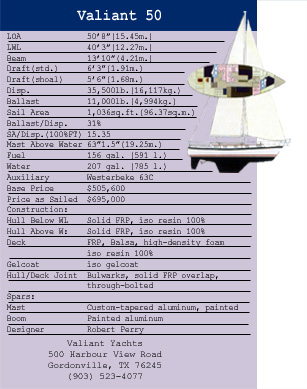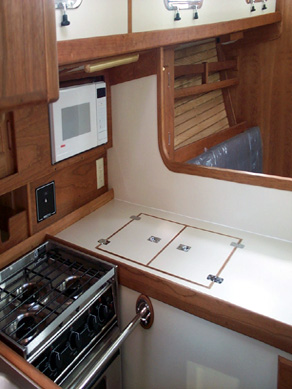strength, stability, performance, safety, and comfort. In an effort to
evaluate the company's claims, I began with a close look at what was going
on in the mold room. What I saw was a flashback to the way good sailboats
once were built. Serrated rollers, carefully catalyzed bucket-mixed resin,
and lots of attention to detail are at the heart of the process. Valiant's
recipe for solid-FRP hull building would be called primitive by race-boat
builders, but for serious ocean passagemakers who are most interested in
long-term structural integrity, the rugged keep-it-simple philosophy makes
lots of sense.
How does Valiant get away with such
low-tech building methods? The answer is simple: good craftsmanship. The
hulls develop stiffness through extra laminate thickness and the bonding of
all interior parts to the hull. In the case of a grounding or a collision
with flotsam, this thicker hull skin means improved tough-
|
ness and point-load resistance. The extra weight associated with the extra
material is near the boat's center of gravity; hence, it doesn't detract
much from the performance of this moderate-displacement cutter. Similarly
built boats from three decades ago are still going strong, and longevity is
certainly a valuable by-product of strength.
You can see
Valiant's back-to-basics hull-building approach in the materials it uses.
There's only one type of isophthalic polyester resin in the shop, and the
laminate schedule is composed of different numbers of layers of 1 1/2-ounce
mat and 24-ounce woven roving, the proven workhorses of FRP fabrics. There's
five to six layers of reinforcement at the sheer, 11 layers at the waterline,
and 20 at the base of the keel stub.
The crew knows that
how you laminate is just as important as how much and what type of material
you use. The guys applying
|

|
layer after layer
demonstrate an attention to detail that's a cut above what we've come to see as
standard industry practice. The Valiant 50 hull is certainly Texas tough.
A Stable Platform
|
holder. The Valiant 50 is no lightweight race boat masquerading as a cruiser,
but neither is it a houseboat unable to tick off serious passage miles. In
truth, I was surprised to see how well the modest-
|
|
 |
With substantial waterline and beam, the Valiant 50 has
good form stability. It's stiff. It's modest 31-percent ballast ratio and
6-foot-3-inch draft afford adequate righting moment and a positive righting
angle to 125 degrees.
However, compared with the Valiant
42's 134-degree range of positive stability, the V-50 does reflect its lower
ballast/displacement ratio. Granted, larger vessels resist capsize more
effectively than smaller vessels, so some decrease in the range of positive
stability can be tolerated. The V-50's long keel foot keeps the CG of lead
ballast reasonably low, and the solidly built cabin house would contribute
to getting the vessel right side up if a wave-induced capsize ever occurred.
Will She Sail?
Performance is like beauty:
It shifts with the eye of the be-
|
sized double-spreader-rigged cutter could move the boat in winds under 10 knots.
It's
a close-winded cruiser with enough uphill manners to make the inevitable beat
doable. Best of all, it has a sail plan that two people can handle, assuming
the crew is fit and willing.
What makes this boat's
sailing manners so appealing is the refinement that has gone on over the years.
Feedback from round-the-world racer Mark Schrader and others who have spent
sea time aboard Valiants have helped fine-tune the placement of sheet leads,
travelers, and winches. The big Lewmar 66 primaries, like the mainsheet-traveler
controls and the stay-
|
|
|